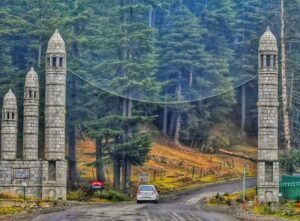Growing up in Kashmir, I’ve always thought of our lands in terms of personalities. Gulmarg is our thrill-seeker with its busy slopes. Meanwhile, Pahalgam stands as our romantic poet beside the Lidder River. Furthermore, Srinagar represents our cultural heart. And Yusmarg? Yusmarg is our quiet family monk. It sits undisturbed in ancient woods. This scenic meadow lies in my home district of Budgam. It’s just 50 kilometers from Srinagar. That’s why Yusmarg remains our cherished local secret, a place close to every Kashmiri’s heart. Keep reading this complete Yusmarg travel guide to know more.
We call it the ‘Meadow of Jesus’ for generations. Consequently, our grandparents told tales of Hazrat Isa (Jesus) walking these pastures. They said he found peace in these mountains during his lost years. However, the truth of these stories matters less than the feeling here. What’s certain is the spiritual calm that surrounds you. Indeed, my family feels tension leave our shoulders when we visit. We’re embraced by rolling emerald meadows from our childhood. Additionally, the whispering pines have witnessed generations of our stories. Gurgling streams that quenched our thirst for centuries serenade us.
In this Yusmarg travel guide, I’ll share what locals know and love. First, I’ll reveal hidden paths my father showed me. Second, you’ll learn about secret spots like the quiet corners of Nilnag Lake. Third, I’ll tell you about the Doodhganga River where my uncles taught me to fish. Finally, I’ll offer practical advice from a lifetime of visits to this peaceful paradise.
Why Yusmarg Remains Our Family Secret: Yusmarg Travel Guide
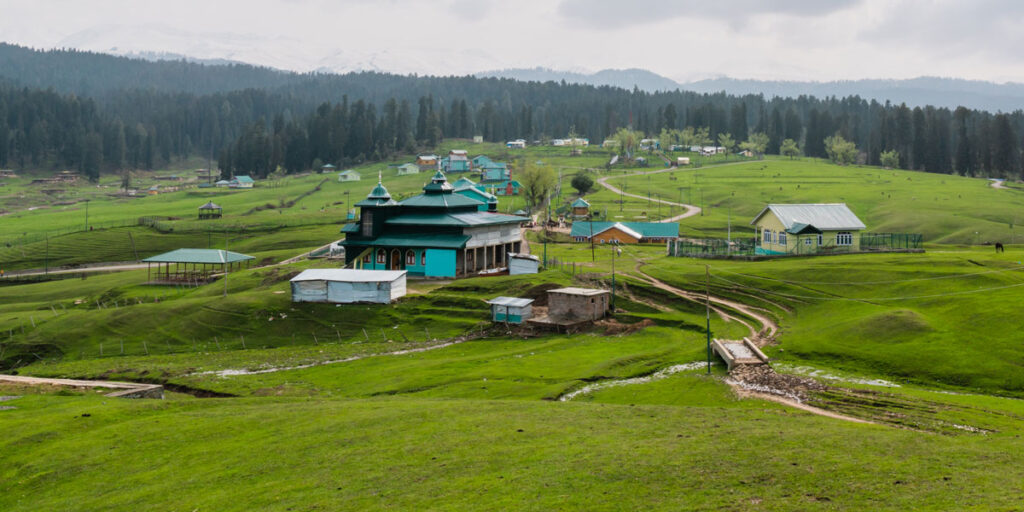
Our Natural Paradise
Yusmarg exists where nature presses pause. We locals have kept it this way on purpose. Our families treasure this place as our weekend retreat. It serves as our festival gathering spot and secret hideaway.
Unlike Gulmarg with its busy gondolas, we’ve kept Yusmarg under the radar. You won’t find the markets that crowd Pahalgam here. No flashy resorts have changed Yusmarg’s face. Instead, you’ll discover what my grandfather called “Kashmir’s true face.” Vast emerald meadows welcome children who roll down grassy slopes as I once did. Ancient pines stand guard over velvet grasslands. Crystal streams carry pristine Himalayan snowmelt that we drink directly without worry.
Local Life and Traditions
When work in Srinagar becomes too much, we come here to breathe. On weekends, local families gather for simple picnics. They spread traditional Kashmiri woven blankets. Furthermore, they share noon chai (salt tea) from steel samovars. Mothers pack crispy bread in willow baskets to pass around. Meanwhile, children play traditional games like kani jung (stone fighting) and gilli danda in the open meadows. Elders exchange weekly news under favorite trees they’ve known for decades.
As a visitor, you’re welcome to join these gatherings. Most Kashmiri families will happily offer you tea and conversation. Someone might teach you how to play satrangi kath (seven stones) if you show interest. In fact, this game requires precision and teamwork. We’ve played it in these meadows for generations.
Did you know? The name “Yusmarg” comes from “Yuz” (Jesus) and “Marg” (meadow). It reflects our ancestral belief that Jesus visited during his travels. My grandmother would point to certain rock formations. “That’s where Hazrat Isa rested and taught wisdom to the mountain people,” she’d say.
Best time to visit: We locals love late spring (May-June). During this time, wildflower carpets transform our meadows into “heaven’s garden.” Purple irises, yellow buttercups, and white daisies create a natural tapestry. Come early morning when mist clings to the grass. The first golden rays pierce through the pine forest. This is when shepherds move their flocks. Consequently, you’ll hear the distant melodic sounds of their flutes echoing across the valley.
Yusmarg Travel Guide: Who Is Yusmarg Ideal For?
- Solo travelers seeking solitude and soulful walks
- Nature lovers enchanted by alpine flora and quiet trails
- Families looking for safe, open spaces to unwind
- Couples wanting scenic beauty minus tourist crowds
- Photography enthusiasts searching for pristine landscapes
Doodhpathri vs Yusmarg? Both offer gorgeous meadows. However, Yusmarg feels more tucked-away and contemplative. If Doodhpathri suits picnicking with friends, Yusmarg calls for journaling under a pine tree. The main meadow stays vast but rarely crowded. This makes it perfect for mindful exploration. Indeed, any good Yusmarg travel guide will tell you this place is more about feeling than seeing.
Expert tip: Yusmarg’s eco-tourism policy and local community involvement ensure it stays clean and natural. Therefore, this helps preserve its authentic character.
Yusmarg Travel Guide: The Journey
Yusmarg lies approximately 50 km southwest of Srinagar. The trip takes about 2 hours. Moreover, the journey itself adds to the charm.
The Scenic Route
- Start from Srinagar and head towards Chadoora, then to Charar-e-Sharief.
- From Charar, a serpentine mountain road leads up to Yusmarg.
- The final stretch weaves through dense pine forests. Sunlight dances through branches. Peaceful villages show life moving at nature’s pace.
Did you know? The road to Yusmarg climbs over 2,000 meters in elevation. As a result, this creates a noticeable temperature drop of about 5-7°C compared to Srinagar. Pack a light jacket even in summer!
Best time to visit: Early autumn (September-October) offers the best drive. During this season, the route lines with golden chinar trees and clear blue skies. Mid-morning departures from Srinagar provide the best visibility and road conditions.
Update (April 11, 2025): The road via Charar-e-Sharief remains open and in good condition. Nevertheless, it narrows and winds in parts. A private taxi or local cab offers your best option for comfort. Therefore, consider hiring a knowledgeable guide who can explain the cultural significance of passing villages.
Yusmarg Travel Guide: Exploring Natural Wonders
The Main Meadow: Yusmarg Travel Guide
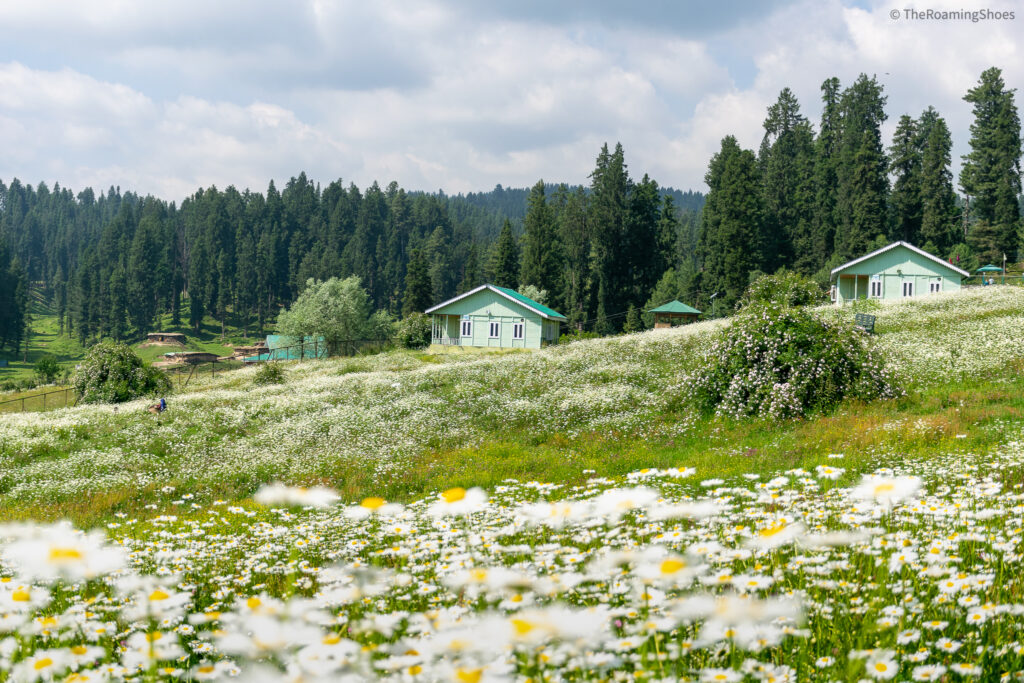
The Heart of Yusmarg
The heart of Yusmarg is what we locals simply call “the marg.” This sprawling alpine meadow has witnessed countless generations of Kashmiri celebrations. The emerald expanse stretches nearly two kilometers. Forests of towering pine, fir, and silver birch embrace it. Our forefathers protected these trees as sacred. Additionally, the meadow undulates with natural terraces. These create perfect amphitheaters for cultural gatherings. My father explains that ancient glaciers formed these contours, not human hands. Yet they serve our communal needs perfectly.
For us Kashmiris, this isn’t just scenery. It’s our community center, playground, and place of reflection. During Eid celebrations, extended families gather for daylong feasts. They spread dastarkhans (dining cloths) with traditional wazwan dishes. Meanwhile, during spring harvests, women sing folk songs as they collect wild herbs. They gather sochal (mallow) and obuj (dandelion) that grow abundantly here. These gatherings continue ancient traditions that connect us to this land.
Visitor Experiences
As a visitor, you’re welcome to:
- Stroll barefoot on the grass as locals do. Feel what we call “earth’s blessing” beneath your feet. Indeed, we believe this connection to soil brings health and grounds the spirit.
- Learn photography from local enthusiasts who gather at specific spots. Ask for “tasveer point” where generations have captured family portraits. They know exactly when golden hour transforms the meadow into “jannat” (paradise).
- Join impromptu cricket matches that break out on summer evenings. Young men from nearby villages compete in friendly tournaments.
Beyond the expected sights, check the meadow corners. Traditional Gujjar shepherds often camp with their flocks there. These nomadic people welcome respectful visitors. Furthermore, they sometimes offer freshly made kalari cheese or noon chai for good conversation. My childhood summers filled with their stories about mountain ghosts and hidden treasures.
Wildlife and Natural Beauty
Look for our wild Kashmiri horses grazing serenely. They descend from ancient Central Asian bloodlines. Our ancestors brought them through mountain passes centuries ago. Moreover, notice local children flying handmade kites from bamboo and old newspapers. This dying art still finds teachers among village elders. Or simply find a quiet corner as I often do. Experience what we call “sukoon”—pristine silence wrapped in fifty shades of green that heals the soul.
Did you know? The main meadow sits at approximately 2,400 meters (7,900 feet) above sea level. Our elders say this precise altitude creates “heaven’s air”—thinner yet more nourishing than valley air. Scientists might explain this as higher oxygen content in pristine forest air. Nevertheless, we’ve known its healing properties for generations!
Best time to visit: We value early summer (June) especially. During this period, wildflowers dot the meadow with purples, yellows and whites. Shepherds’ flocks haven’t yet grazed the grass too short. Come mid-afternoon when sunlight fully illuminates the valley. The breeze carries pine scent mixed with smoke from distant shepherd camps. Stay until dusk when we gather for communal evening prayers. Even non-Muslims may sit quietly then and experience the spiritual harmony.
Doodhganga River: Yusmarg Travel Guide

The Sacred Waters
A short pony ride or trek (30–45 minutes) from the meadow takes you to Yusmarg’s true treasure. We locals cherish the Doodhganga River above all. My grandmother named it for me as a boy: “doodh” meaning milk and “ganga” meaning sacred river. Its frothy, white water crashes down the valley with force and purity. It truly resembles flowing milk from heaven.
The riverbed, visited by my family for five generations, features smooth, polished stones. We Kashmiris collect these for medicinal purposes. Many local homes place river stones in water vessels. We believe they purify drinking water naturally. Meanwhile, dramatic cliffs rise on either side. They create what we call “nature’s mosque.” This corridor of stunning beauty draws many locals for spiritual reflection rather than built mosques in villages.
Traditional River Activities
For generations, this river has centered our lives:
- Local fishermen still use traditional techniques to catch indigenous snow trout. They use hand-woven willow baskets. With respect and genuine interest, they might demonstrate these nearly-forgotten family skills.
- During summer, village elders bring young boys for swimming lessons in calmer pools. Consequently, they teach techniques specially adapted to cold mountain waters.
- Women from nearby villages gather at designated upstream spots. There they wash special textiles and carpets requiring the mineral-rich water that makes Kashmir famous.
As a visitor, you can:
- Join local youth who navigate safer rapids sections on inflated goatskin floats (called “sheen”). However, I recommend an experienced local guide for this activity.
- Learn stone skipping from village children who compete for the most bounces across calm sections. Our record holder is young Sameer with 13 skips!
- Participate in riverside picnics where families cook fresh trout wrapped in walnut leaves. They place them directly on heated river stones—a centuries-old technique.
Trail and Riverbank
I must caution you—the trail runs steeper than most tourists expect. Even we locals who’ve walked it hundreds of times wear traditional leather footwear with good ankle support. The path follows ancient shepherd routes that value efficiency over comfort.
The riverbank offers breathtaking beauty. Dark metamorphic rocks frame it. Local geologists tell us these rocks exceed 40 million years in age. Furthermore, the thick pine cover creates dappled, magical light. We Kashmiris believe this light heals eye ailments. Therefore, many elders with failing vision sit by these waters regularly.
Did you know? The Doodhganga River originates from “the tears of the mountains”—the Pir Panjal range’s glacial melt. Eventually, it joins our lifeline, the Jhelum River. Its water shows such purity that our traditional hakims (healers) prescribe it for kidney ailments. In fact, my uncle travels here monthly to collect water in copper vessels for this purpose.
Best time to visit: We prize late spring (May) when snowmelt increases the river’s flow. This creates spectacular white-water displays we call “nature’s tantrum.” During this time, village elders perform thanksgiving rituals for the water’s return after winter. Morning visits offer rainbow prisms in the water spray. Additionally, you’ll likely meet local shepherds bringing their flocks for their first daily drink.
Experience Tip: The return climb requires moderate exertion. Therefore, take breaks, stay hydrated, and plan accordingly. The best view? Look just upriver from the main stop point. Find a natural rock bench under the trees. A local guide can point out the easiest paths and safest viewing spots.
Nilnag Lake: Yusmarg Travel Guide

A Sacred Blue Jewel
Hidden within “devdar sansar” (the world of cedars) lies Nilnag Lake. This place holds such sacredness for us Kashmiris that many older villagers still perform ritual walks before fishing its waters. This small but scenic waterbody carries the name “blue lake” in our Kashmiri language. Its clear turquoise water reflects surrounding mountains perfectly. Moreover, our poets have written about it for centuries.
This isn’t just a pretty photo spot—it’s living cultural heritage. Dense coniferous forest embraces the lake. Our ancestors protected it through “kuth raksha” (sacred grove protection). Consequently, this created a microclimate harboring unique regional plant species. As children, we learned never to break branches or pick flowers within sight of the lake.
The Journey to Nilnag
The journey follows paths that my grandfather says mystic poets established seeking isolation:
- Trek/pony ride covers ~4 km one way (1 to 1.5 hours) through “dream forest.”
- The trail stays forested and shaded by centuries-old trees. The path remains blissfully quiet. Furthermore, we Kashmiris often walk it in complete silence as moving meditation.
- Fishing here follows deep traditions. Local anglers use hand-carved walnut wood rods and generational techniques. Visitors can obtain permits. Therefore, I recommend asking a local fisherman to accompany you to learn proper methods.
Cultural Significance
Nilnag holds special meaning for different local communities:
- Gujjar shepherds mark the lake as an important watering hole on seasonal migration routes. They time journeys to coincide with specific moon phases over the lake.
- Traditional Kashmiri herbalists find rare medicinal plants on the lakeshore. Thus, they collect these during precisely timed yearly expeditions.
- Village elders use the lake as a natural calendar. They predict weather patterns based on subtle color changes and water behavior.
As a visitor, you can:
- Join early morning fishing with local anglers who still use traditional methods to catch Kashmir trout. They can teach “thaap” fishing using natural bait.
- Learn about edible forest plants from knowledgeable villagers. They supplement their diets with wild foods gathered around the lake.
- Participate in “koshur kath” (Kashmiri storytelling) that often happens on the lakeshore during summer evenings.
Preserving Natural Beauty
Remember, we have purposely kept this place free from commercial development. You’ll find no shops, no tea stalls, nothing to dilute its natural essence. This explains why we locals always carry wicker baskets with noon chai (salt tea) in copper kettles. We bring tsot (Kashmiri bread) for lakeside refreshment. I recommend you do the same. However, please take all waste back with you. We’ve kept this place pristine for centuries and wish to maintain this standard.
Did you know? According to our ancestral folklore, Nilnag Lake formed from a mountain fairy’s tears. She fell in love with a human shepherd but could never join him in the valley below. We believe its waters heal skin ailments. Indeed, my aunt still collects lake water in clay pots during the full moon to treat eczema. The lake’s blue-green color comes from special minerals. Our traditional dyers once tried to copy this color for the finest pashmina shawls.
Best time to visit: We value late summer (August) when water levels reach optimal height after receiving mountain snowmelt. Surrounding forests display at least seven distinct green shades. We have specific Kashmiri names for each. Visit around noon when sunlight penetrates the forest canopy to illuminate the lake’s vibrant colors. Village elders say the water “speaks” through its changing hues at this time. Nevertheless, avoid the third week of August when the lake undergoes its annual algal bloom. We call this “water’s renewal.”
Charar-e-Sharief Shrine: Yusmarg Travel Guide
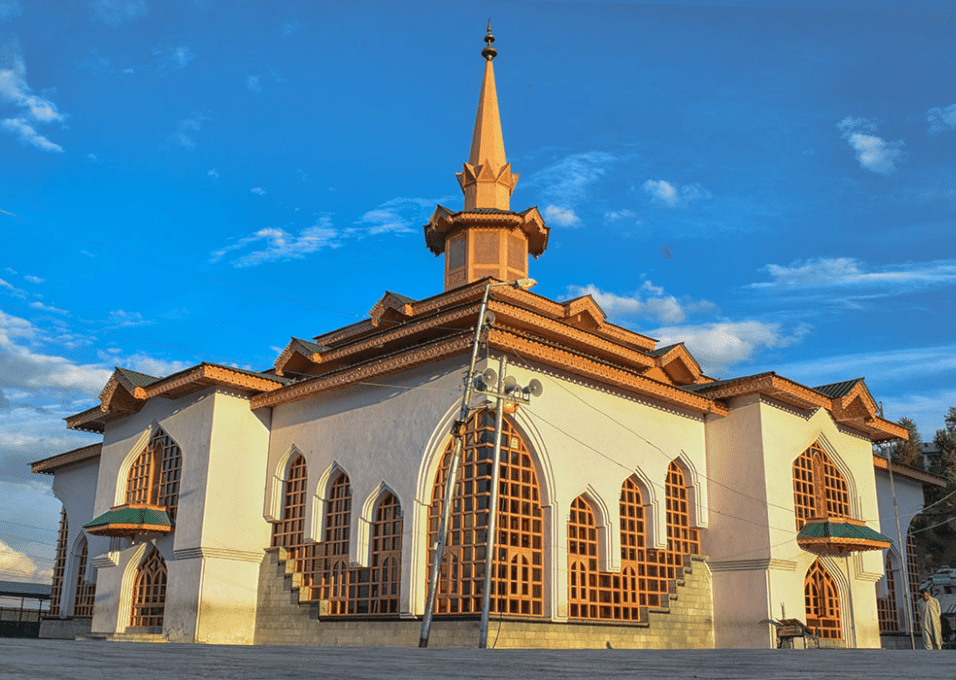
A Spiritual Gateway
On the way to Yusmarg lies what we consider Budgam district’s spiritual gateway—Charar-e-Sharief. My family has marked every significant life event here for generations. Built to honor Sheikh Noor-ud-din Wali, whom we call “Alamdar-e-Kashmir” (Flag Bearer of Kashmir) or simply “Nund Rishi,” this wooden marvel represents Kashmiri religious identity.
The shrine design reflects our unique Kashmir aesthetic—neither purely Indian nor Central Asian. It shows a distinctive synthesis we’ve developed over centuries. Master artisans from my mother’s ancestral village crafted the intricate latticework (called “pinjrakari”). The distinctive spires reaching skyward (known as “burji”) represent our connection between earth and heaven. Moreover, look closely at the ceiling work. Those aren’t random patterns but ancient Kashmiri cosmological symbols. They represent harmony among all faiths.
Community Functions
The shrine functions beyond a religious monument:
- It serves as our community’s dispute resolution center. Village elders still gather to solve conflicts through traditional mediation here.
- During special occasions like Urs (saint’s death anniversary celebrations), the shrine becomes a cultural hub. Kashmiri folk singers perform centuries-old devotional music called “dhamal.”
- The langar (community kitchen) feeds thousands daily regardless of religion or background. In fact, my grandfather helped maintain this tradition as a volunteer cook for decades.
Visitor Experiences
As a visitor, you can:
- Observe or join the ritual tying of colored threads on shrine windows. These represent prayers and wishes. Though as Muslims we don’t technically approve this practice, it shows the syncretic nature of Kashmiri spirituality.
- Listen to impromptu qawwali performances that often occur in the outer courtyard during afternoons.
- Sample traditional “tabarruk” sweets distributed after prayers. These follow recipes unchanged for centuries.
- Learn about Kashmir’s unique Rishi tradition that blended Islamic mysticism with local spiritual practices. This created a distinctly tolerant religious approach.
Visitor Etiquette
During your visit, please:
- Dress modestly as you would in your own place of worship. Cover shoulders and knees. Women should wear head scarves if possible. My mother keeps extra scarves to offer visitors.
- Remove shoes before entering the inner sanctum. Look for the special walnut wood shelves for visitors’ footwear.
- Maintain respectful silence during prayer times. Feel free to observe the rituals many of us have performed daily since childhood.
Did you know? The original shrine built in the 15th century burned in a tragic 1995 fire. Every Kashmiri of my generation remembers this with profound sadness. The reconstruction preserved its historical design, though locals like my grandfather can point out subtle differences. Sheikh Noor-ud-din Wali, the honored saint, developed a unique ecological philosophy centuries ahead of his time. His poetry, which we still recite, contains specific instructions about forest conservation and water protection. These guided traditional Kashmiri environmental practices.
Best time to visit: We prefer early morning visits (before 9 AM) to experience “sakoon-e-rooh” (peace of the soul). This happens when first light filters through colored glass windows. It creates patterns on the interior walls. You’ll see devoted locals performing centuries-old rituals then. You can experience the shrine’s true spiritual essence. Additionally, Thursday evenings hold special significance with additional prayers and singing. Any knowledgeable guide can introduce you to caretaker families who have maintained the shrine for generations. They share stories absent from any guidebook.
Yusmarg Travel Guide: Active Adventures
While Yusmarg invites slowing down rather than ticking boxes, plenty of activities await:
Pony Riding Through Alpine Meadows
- Popular for reaching Doodhganga and Nilnag
- Rates allow negotiation—agree firmly but politely (expect 500-800 rupees per hour)
- Always check saddle condition and pony health before mounting
Did you know? The ponies used in Yusmarg typically belong to the Kashmiri pony breed. These hardy mountain animals adapt well to high altitudes and rough terrain. In fact, people have used them for Himalayan transportation for centuries!
Best time to experience: Choose mid-morning in summer when temperatures feel pleasant and meadows bathe in soft light. Furthermore, spring rides offer wildflower views while autumn rides showcase golden light on amber grasses.
Trekking & Hiking Through Pristine Wilderness
- Easy: Meadow walks and short forest trails (1-2 hours)
- Moderate: Nilnag Lake trek (4 km, 2-3 hours round trip)
- Challenging: Sang-e-Safed Valley trek (needs local guide, full-day hike through varied terrain)
Did you know? The Sang-e-Safed trek takes you near a white rock formation. Locals believe it changes shade depending on sunlight angle—hence the name meaning “White Stone.”
Best time to trek: Early summer (June-July) offers manageable temperatures and clear trails. Therefore, start early (6-7 AM) to avoid afternoon mountain showers common in the region.
Photography & Picnicking in Nature’s Gallery
- Ideal for landscape photography, especially at dawn/dusk when light paints meadows gold
- Pack your own picnic for an unforgettable outdoor lunch overlooking sweeping valleys
- Look for macro photography opportunities among diverse alpine flowers
Did you know? Yusmarg’s unique position in the Pir Panjal range creates “layered mountains” in the distance. As a result, these offer perfect dramatic landscape shots with depth.
Best time for photography: Choose early morning (golden hour just after sunrise) for misty meadows and warm light. Evening (6-7 PM) works well too when shadows lengthen and mountains turn purple.
Do Absolutely Nothing (The Yusmarg Specialty)
- Read a book under a pine tree, feeling the gentle mountain breeze
- Listen to wind and birds, experiencing nature’s symphony without digital distractions
- Let the stillness heal you—something increasingly rare in our connected world
Did you know? Yusmarg’s elevation and pristine environment produce some of India’s cleanest air. Its exceptionally high oxygen content explains why visitors often feel rejuvenated after just a short stay.
Best time for mindfulness: Any season during mid-afternoon works well. The valley becomes fully illuminated then and wildlife stays active. Consequently, find a quiet spot away from the main meadow entrance for the most peaceful experience.
Yusmarg Travel Guide: Practical Details
Accommodation Options
Options remain limited but authentic:
- JKTDC Tourist Huts (basic but cozy wooden cabins with stunning views, advance booking required)
- Homestays in nearby villages (authentic Kashmiri hospitality and home-cooked meals)
- Stay in Srinagar and plan a day trip with an early start
Did you know? The JKTDC huts in Yusmarg use traditional Kashmiri architecture techniques. Their sloping roofs shed snow effectively. Additionally, the interiors feature local woodwork.
Best time to book: Spring and autumn accommodations need reservation 2-3 weeks ahead. Summer stays require booking 1-2 months in advance, especially for weekends.
Update (April 11, 2025): Book JKTDC huts online at JKTDC’s official site. They fill quickly in peak season! Therefore, consider asking a guide for help with booking authentic homestays that don’t appear online.
Food & Refreshments
- Basic stalls near the meadow offer Kashmiri kahwa tea, snacks, and Maggi noodles
- For treks: carry water, fruit, nuts, and energy bars
- Homestays typically serve traditional Kashmiri meals including rajma chawal, nadru yakhni, and kehwa
Did you know? The water used for tea in Yusmarg comes directly from mountain springs. This gives it a distinct mineral taste that enhances Kashmiri kahwa flavor.
Best food experiences: Try early evening meals at homestays when families prepare traditional dishes. Similarly, mid-morning tea at meadow stalls works well too when fresh bread arrives from nearby villages.
Best Seasons for Visiting: Yusmarg Travel Guide
- May to August: Lush emerald meadows, pleasant temperatures (15-25°C), wildflowers in full bloom
- September to October: Autumn gold transforms the landscape, crisp air (10-20°C), perfect photography light
- Winter (November-April): Not recommended—roads often close from snow and facilities shut down
Did you know? During peak summer, Yusmarg enjoys nearly 14 hours of daylight. As a result, this gives visitors plenty of time to explore without rushing.
Best overall time: Late June weekdays combine perfect weather with minimal crowds. Your guide might suggest specific weeks when wildflowers reach their peak.
Facilities & Connectivity
- Mobile Network: Patchy at best (BSNL may work, but other carriers have limited coverage)
- Medical: Closest facility waits at Charar-e-Sharief (30 minutes away)
- Toilets: Limited; JKTDC hut complex offers some basic options
- ATM: None in Yusmarg—bring sufficient cash from Srinagar
Did you know? The limited connectivity in Yusmarg helps preserve its tranquility. Therefore, it remains one of Kashmir’s few places where digital detox happens naturally.
Best preparation: Download offline maps before your visit and tell family about your itinerary. Consequently, a reliable guide can help navigate when digital maps fail.
Final Reflections: Why We Kashmiris Always Return to Yusmarg
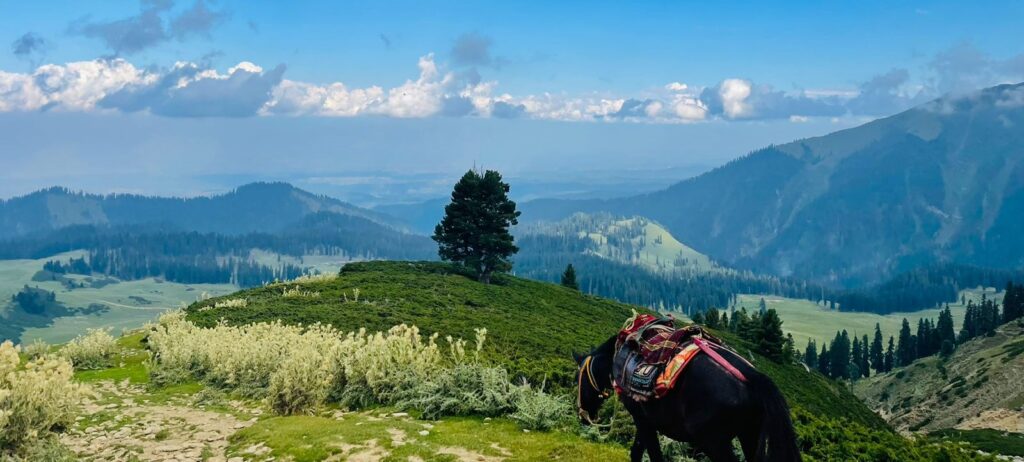
A Living Heritage
Is Yusmarg truly Kashmir’s most tranquil hidden gem? As someone whose family has visited this meadow for seven generations, let me share what we tell our children.
Yusmarg isn’t just a destination—it forms part of our Kashmiri identity. While tourists flock to Gulmarg’s gondolas or Pahalgam’s manicured gardens, we locals bring our families here because it remains authentically ours. For instance, my grandfather requested to hear Yusmarg sounds one last time when he lay dying. My father recorded the distinctive pine rustle that sounds unlike trees anywhere else.
If you want crowds, cafes, and commercial commotion that have transformed other valley parts—please look elsewhere. We have purposely preserved Yusmarg as a sanctuary from that world. But perhaps you seek verdant meadows stretching to snow-capped horizons. We’ve named these individually over centuries. Maybe you long for milky rivers carving valleys along ancestral routes. Or possibly you desire the soothing hush of pine forests where our folk stories say jinns (spirits) still dance by moonlight. In that case, Yusmarg might become as special to you as it remains to us.
Authentic Experiences
It lacks the flash of Dal Lake houseboats. It misses the Insta-fame of Srinagar’s tulip gardens. Nevertheless, it offers something real, peaceful, and unforgettable. Here you can still hear yourself think. You can feel your soul expand. Furthermore, you can experience the Kashmir that we locals treasure.
For generations, different communities have used this space in harmony:
- Village women gather seasonal mushrooms and wild greens. Meanwhile, they use sustainable harvesting techniques taught to daughters as they work.
- Young shepherds learn traditional navigation from elders. Therefore, they use natural formations as their only guide.
- Craftspeople from nearby villages collect specific pine resins. As a result, these help create traditional Kashmir woodwork finishes.
- Religious scholars from various faiths retreat here. Consequently, they focus on contemplative writing and teaching.
As a visitor, you can respectfully observe these practices. With proper introduction, you sometimes may participate. Many families welcome interested guests to join mushroom foraging. Similarly, some invite visitors to help collect autumn pine nuts.
For Whom Is Yusmarg Ideal?
- Peace-seekers tired of commercialization affecting other Kashmiri destinations
- Nature lovers who appreciate subtle beauty celebrated by local poets for centuries
- Day-trippers from Srinagar willing to start early (as my family does most weekends)
- Anyone looking to press pause and truly feel Kashmir’s heartbeat as locals experience it
- Travelers seeking authentic cultural exchange rather than staged performances
The True Essence of Yusmarg
The most meaningful Yusmarg experiences don’t come from scheduled activities. Instead, they arrive through simple moments treasured by Kashmiris across generations. Watch clouds cast shadows racing across meadows like spirits from our folktales. Hear wind whisper secrets through ancient pines that we believe hold ancestral memories. Simply breathe air scented with wildflowers and wilderness. This air has nourished our people since time immemorial.
A knowledgeable guide—preferably someone born in surrounding villages like my cousin—can help. Such a person shares our family’s generations of knowledge. Finally, they introduce the meadow not as a map location but as a living extension of Kashmiri identity, history, and future.

